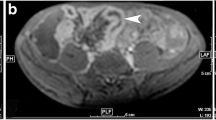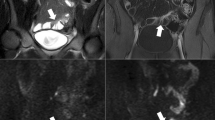Abstract
Purpose
To retrospectively investigate the added value of diffusion-weighted MR imaging (DWI) for detecting mesenteric small bowel tumours (MSBTs) via MR-enterography.
Materials and methods
MR-enterographies of 98 patients with suspected MSBTs were blindly analyzed by two independent readers for the presence of MSBTs. Four imaging sets including “standard” (Haste and TrueFisp), “standard + DWI,” “standard + gadolinium-enhanced” and “standard + DWI + gadolinium-enhanced” were reviewed. Diagnostic performance of different readings were compared with McNemar’s test.
Results
Twenty-nine MSBTs were pathologically confirmed. For R1 (junior radiologist) sensitivity, specificity, PPV, NPV and accuracy for the detection of MSBTs via standard MRI were 52 % [95 % CI: 34 %-70 %] (15/29), 94 % [95 % CI: 89 %-100 %] (65/69), 79 % [95 % CI: 61 %-97 %] (15/19), 82 % [95 % CI: 74 %-91 %] (65/79) and 82 % [95 % CI: 74 %-89 %] (80/98), respectively. For R2 (senior radiologist) they were 76 % [95 % CI: 60 %-91 %] (22/29), 96 % [95 % CI: 91-100 %] (66/69), 88 % [95 % CI: 75 %-100 %] (22/25), 90 % [95 % CI: 84 %-97 %] (66/73) and 90 % [95 % CI: 84 %-96 %] (88/98), respectively. Adding DWI they were 72 % [95 % CI: 56 %-89 %] (21/29), 91 % [95 % CI: 85 %-98 %] (63/69), 78 % [95 % CI: 62 %-94 %] (21/27), 89 % [95 % CI: 81 %-96 %] (63/71) and 87 % [95 % CI: 80 %-94 %] (85/98) for R1 and 79 % [95 % CI: 65 %-94 %] (23/29), 97 % [95 % CI: 93 %-100 %] (67/69), 92 % [95 % CI: 81 %-100 %] (23/25), 92 % [95 % CI: 86 %-98 %] (67/73) and 92 % [95 % CI: 86 %-97 %] (90/98) for R2. Sensitivities for tumour detection were higher after adding DWI to standard MRI, although only for R1 was this significant (P = 0.03). Adding DWI to standard + gadolinium-enhanced MRI did not significantly increase MR performance.
Conclusion
DWI improves MSBT detection via MR-enterography compared to standard unenhanced MR-enterography, especially for unexperienced readers.
Key Points
• MR-enterography is accurate for the detection of mesenteric small-bowel tumours.
• Diffusion-weighted sequencing helps inexperienced readers detect small-bowel tumours with MR-enterography.
• Diffusion-weighted sequencing adds value to standard MR-enterography when gadolinium is contraindicated.



Similar content being viewed by others
Abbreviations
- MSBT:
-
Mesenteric small-bowel tumour
- VCE:
-
Videocapsule endoscopy
- CT:
-
Computed tomography
- MR:
-
Magnetic resonance
- PEG:
-
Polyethylene glycol
- HASTE:
-
Half-Fourier single-shot spin echo
- TrueFISP:
-
True free-induction with steady state free precession
- VIBE:
-
Volumetric interpolated breath hold
- MDCT:
-
Multidetector computed tomography
- PPV:
-
Positive predictive value
- NPV:
-
Negative predictive value
- CI:
-
Confidence interval
- SD:
-
Standard deviation
- GIST:
-
Gastrointestinal stromal tumour
- DWI:
-
Diffusion weighted magnetic resonance image
- ADC:
-
Apparent diffusion coefficient
References
Amzallag-Bellenger E, Oudjit A, Ruiz A, Cadiot G, Soyer P, Hoeffel C (2012) Effectiveness of MR enterography for the assessment of small-bowel diseases beyond Crohn disease. Radiographics 32:1423–1444
Soyer P, Boudiaf M, Fishman EK et al (2011) Imaging of malignant neoplasms of the mesenteric small bowel : new trends and perspectives. Crit Rev Oncol Hematol 80:10–30
Masselli G, Polettini E, Casciani E, Bertini L, Vecchioli A, Gualdi G (2009) Small bowel neoplasms: prospective evaluation of MR enteroclysis. Radiology 251:743–750
Van Weyenberg SJ, Meijerink MR, Jacobs MA et al (2010) MR enteroclysis in the diagnosis of the small-bowel neoplasms. Radiology 254:765–773
Gupta A, Postgate AJ, Burling D et al (2010) A prospective study of MR enterography versus capsule endoscopy for the surveillance of adult patients with Peutz-Jeghers syndrome. AJR Am J Roentgenol 195:108–116
Amzallag-Bellenger E, Soyer P, Barbe C, Diebold MD, Cadiot G, Hoeffel C (2013) Prospective evaluation of magnetic resonance enterography for the detection of mesenteric small bowel tumours. Eur Radiol 23:1901–1910
Sinha R, Rajiah P, Ramachandran I, Sanders S, Murphy PD (2013) Diffusion-weighted MR imaging of the gastrointestinal tract: technique, indications, and imaging findings. Radiographics 33:655–676
Colosio A, Fornès P, Soyer P, Lewin M, Loock M, Hoeffel C (2013) Local colorectal cancer recurrence: pelvic MRI evaluation. Abdom Imaging 38:72–81
Colosio A, Soyer P, Rousset P et al (2013) Value of diffusion-weighted and gadolinium-enhanced MRI for the diagnosis of pelvic recurrence from colorectal cancer. J Magn Reson Imaging 40:306–13
Klauss M, Lemke A, Grünberg K et al (2011) Intravoxel incoherent motion MRI for the differentiation between mass forming chronic pancreatitis and pancreatic carcinoma. Investig Radiol 46:57–63
Fleiss JL (1981) Statistical methods for rates and proportions, 2nd edn. Wiley, New York
Lohan DG, Alhajeri AN, Cronin CG, Roche CJ, Murphy JM (2008) MR enterography of small-bowel lymphoma: potential for suggestion of histologic subtype and the presence of underlying celiac disease. AJR Am J Roentgenol 190:287–293
Maccioni F, Al Ansari N, Mazzamurro F, Barchetti F, Marini M (2012) Surveillance of patients affected by Peutz-Jeghers syndrome: diagnostic value of MR enterography in prone and supine position. Abdom Imaging 37:279–287
Masselli G, Polettini E, Laghi F, Monti R, Gualdi G (2014) Non inflammatory conditions of the small bowel. Magn Reson Imaging Clin N Am 22:51–65
Kavaliauskiene G, Ziech ML, Nio CY, Stoker J (2011) Small bowel MRI in adult patients: not just Crohn's disease-a tutorial. Insights Imaging 2:501–513
Masselli G, Gualdi G (2010) Evaluation of small bowel tumors: MR enteroclysis. Abdom Imaging 35:23–30
Kilickesmez O, Atilla S, Soylu A et al (2009) Diffusion-weighted imaging of the rectosigmoid colon: preliminary findings. J Comput Assist Tomogr 33:863–866
Kiryu S, Dodanuki K, Takao H et al (2009) Free-breathing diffusion-weighted imaging for the assessment of inflammatory activity in Crohn’s disease. J Magn Reson Imaging 29:880–886
Oto A, Zhu F, Kulkarni K, Karczmar GS, Turner JR, Rubin D (2009) Evaluation of diffusion-weighted MR imaging for detection of bowel inflammation in patients with Crohn’s disease. Acad Radiol 16:597–603
Oto A, Kayhan A, Williams JT et al (2011) Active Crohn’s disease in the small bowel: evaluation by diffusion weighted imaging and quantitative dynamic contrast enhanced MR imaging. J Magn Reson Imaging 33:615–624
Oussalah A, Laurent V, Bruot O et al (2010) Diffusion-weighted magentic resonance without bowel preparation for detecting colonic inflammation in inflammatory bowel disease. Gut 59:1056–1065
Maccioni F, Patak MA, Signore A, Laghi A (2012) New frontiers of MRI in Crohn’s disease: motility imaging, diffusion-weighted imaging, perfusion MRI, MR spectroscopy, molecular imaging, and hybrid imaging (PET/MRI). Abdom Imaging 37:974–982
Placé V, Hristova L, Dray X, Lavergne-Slove A, Boudiaf M, Soyer P (2012) Ileal adenocarcinoma in Crohn’s disease: magnetic resonance enterography features. Clin Imaging 36:24–28
Ichikawa T, Erturk SM, Motosugi U et al (2006) High-B-value diffusion-weighted MRI in colorectal cancer. AJR Am J Roentgenol 187:181–184
Parikh T, Drew SJ, Lee VS et al (2008) Focal liver lesion detection and characterization with diffusion-weighted MR imaging: comparison with standard breath-hold T2-weighted imaging. Radiology 246:812–822
D’Assignies G, Fina P, Bruno O et al (2013) High sensitivity of diffusion-weighted MR imaging for the detection of liver metastases from neuroendocrine tumors: comparison with T2-weighted and dynamic gadolinium-enhanced MR imaging. Radiology 268:390–399
Soussan M, Des Guetz G, Barrau V et al (2012) Comparison of FDG-PET/CT and MR with diffusion-weighted imaging for assessing peritoneal carcinomatosis from gastrointestinal malignancy. Eur Radiol 22:1479–1487
Soyer P, Boudiaf M, Placé V, Sirol M, Pautrat K, Vignaud A et al (2011) Preoperative detection of hepatic metastases: comparison of diffusion-weighted, T2-weighted fast spin echo and gadolinium-enhanced MR imaging using surgical and histopathologic findings as standard of reference. Eur J Radiol 80:245–252
Buisson A, Joubert A, Montoriol PF et al (2013) Diffusion-weighted magnetic resonance imaging for detecting and assessing ileal inflammation in Crohn’s disease. Aliment Pharmacol Ther 37:537–545
Takahara T, Kwee TC, Sadahiro S et al (2011) Low b-value diffusion-weighted imaging for diagnosing strangulated small bowel obstruction: a feasibility study. J Magn Reson Imaging 34:1117–1124
Lambregts DM, Cappendjk VC, Maas M, Beets GL, Beets-Tan RG (2011) Value of MRI and diffusion-weighted MRI for the diagnosis of locally recurrent rectal cancer. Eur Radiol 21:1250–1258
Barral M, Sebbag-Sfez D, Hoeffel C, Chaput U, Dohan A, Eveno C, Boudiaf M, Soyer P (2013) Characterization of focal pancreatic lesions using normalized apparent diffusion coefficient at 1.5-Tesla: preliminary experience. Diagn Interv Imaging 94:619–627
Koh DM, Collins DJ (2007) Diffusion-weighted MRI in the body: applications and challenges in oncology. AJR Am J Roentgenol 188:1622–1635
Soyer P, Aout M, Hoeffel C, Vicaut E, Placé V, Boudiaf M (2013) Helical CT-enteroclysis in the detection of small-bowel tumours: a meta-analysis. Eur Radiol 23:388–399
Acknowledgements
The scientific guarantor of this publication is Pr. Hoeffel. The authors of this manuscript declare no relationships with any companies whose products or services may be related to the subject matter of the article. The authors state that this work has not received any funding. One of the authors has significant statistical expertise: Dr Coralie Barbe. Institutional review board approval was obtained. Written informed consent was not required for this study because the institutional review board waived informed consent for the patients. Approval from the institutional animal care committee was not required because animals were not involved in the study. Some study subjects or cohorts (45 patients) have been previously reported in “Prospective evaluation of magnetic resonance enterography for the detection of mesenteric small bowel tumours. Eur Radiol 2013; 23(7): 1901-10.” Methodology: retrospective, observational, performed at one institution.
Author information
Authors and Affiliations
Corresponding author
Rights and permissions
About this article
Cite this article
Amzallag-Bellenger, E., Soyer, P., Barbe, C. et al. Diffusion-weighted imaging for the detection of mesenteric small bowel tumours with Magnetic Resonance--enterography. Eur Radiol 24, 2916–2926 (2014). https://doi.org/10.1007/s00330-014-3303-x
Received:
Revised:
Accepted:
Published:
Issue Date:
DOI: https://doi.org/10.1007/s00330-014-3303-x




